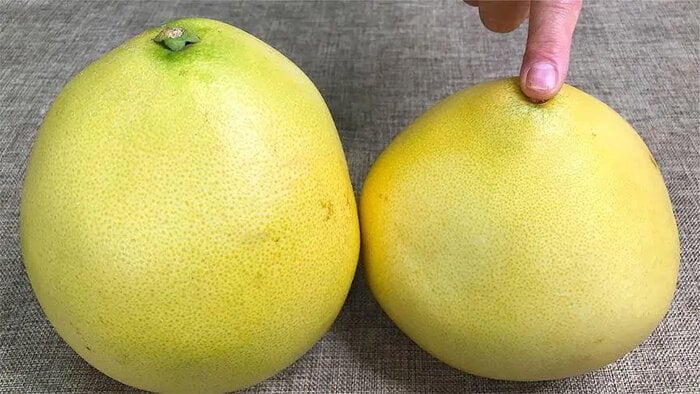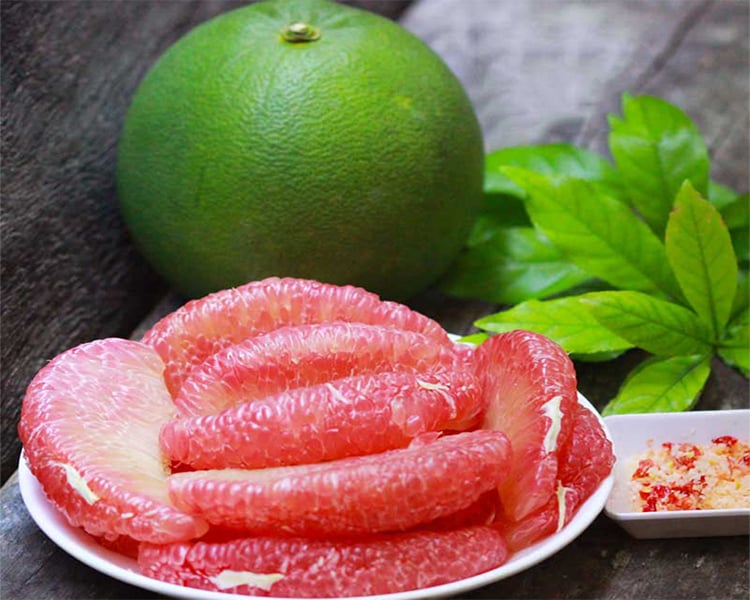It’s not uncommon to find a mix of good and not-so-good pomelos on the same tree, leaving consumers with a tricky choice. Experienced farmers suggest paying attention to these five telltale signs to determine if a pomelo is worth your taste buds’ while.
5 Signs of a Delicious Pomelo
According to seasoned pomelo growers, the following five factors are key to selecting a juicy, sweet, and mouthwatering pomelo:
+ Go for larger fruits over smaller ones.

The first rule of thumb when buying pomelos is to opt for larger fruits.
When it comes to pomelos, size does matter. Given the same variety and growing conditions, larger pomelos tend to absorb more nutrients, resulting in a sweeter and more aromatic fruit compared to their smaller counterparts. Smaller pomelos are often drier, with a bitter taste, indicating they may not be fully ripe.
+ Heavier fruits are preferable to lighter ones.
When faced with a selection of pomelos, you can gauge their quality by picking them up and feeling their weight. Among visually similar pomelos, the heavier ones tend to have thinner skins, larger segments, and are juicier and sweeter. Lighter pomelos, on the other hand, tend to have thicker skins, less pulp, and a less appealing flavor profile.
+ Opt for softer pomelos over firmer ones.
A simple way to assess the ripeness of a pomelo is by pressing it gently with your hand. Pomelos that are firm and less resilient tend to have thicker skins, fewer segments, and are more likely to be dry and sour. Softer, more pliable pomelos indicate thinner skins, juicier flesh, and a sweeter taste. Thus, when in doubt, go for the softer fruit.
+ For yellow pomelos, avoid green-hued fruits.
A well-ripened pomelo will exhibit a bright yellow color, with an even and natural hue. If the skin has green patches or the area around the stem remains green, it’s a sign that the pomelo isn’t quite ready for consumption and may not taste as good. Of course, this rule doesn’t apply to green-skinned pomelo varieties.
+ Smooth-skinned pomelos are preferable to rough-skinned ones.
In addition to color, you can also judge a pomelo’s freshness by running your hand over its skin. A smooth, moist, and glossy skin indicates a fresh pomelo, free from dryness and sponginess. Conversely, a rough, dry, and coarse-textured skin suggests an older pomelo that may not taste as good.
Note: To extend the shelf life of pomelos, store them in a cool, dry place, away from direct sunlight. Under normal conditions, pomelos can be stored for up to one to two months. For peeled or segmented pomelos, place them in an airtight container and refrigerate to prolong their freshness.

A smooth, moist, and glossy skin is a sign of a fresh pomelo.
Health Benefits of Pomelos
+ Boosts Immune System
Rich in vitamin C, pomelos help strengthen your immune system. Vitamin C also plays a role in preventing oral and stomach cancers, reducing the risk of stroke and heart disease.
+ Prevents Kidney Stones
Kidney stones are formed by the buildup of calcium over time. Consuming a liter of pomelo juice daily can help prevent the formation of kidney stones and spare you the associated pain.
+ Aids in Weight Loss
Drinking a glass or half a glass of pomelo juice before meals can help you shed 1.8 kg in just twelve weeks.
+ Detoxifies the Liver
Pomelo juice helps cleanse the liver and flush out toxins, promoting a healthier liver.
+ Reduces Harmful Cholesterol
Research indicates that regular consumption of pomelos or their juice can lower harmful cholesterol levels by up to 15%.
+ Enhances Skin Health
The high vitamin C content in pomelos acts as a powerful antioxidant, neutralizing free radicals and reducing oxidative stress, while also promoting collagen production for healthier skin.































